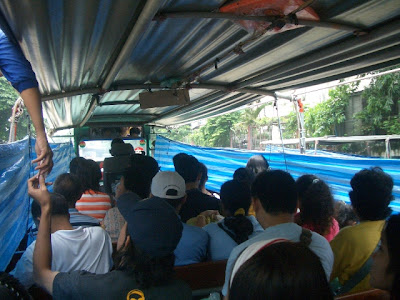Nowadays, one would still see the remnants of the once bustling klongs as fetid waterways. Not all klongs however have been abandoned. In fact, given the horrendous traffic situation of the city (truly an understatement there), one major klong serve as a faster alternative to get from one point to another. It runs across Bangkok, passing through the commercial districts of Sukhumvit, Pratunam, and all the way to the old section of Banglamphu and Rattanakosin.
Last Saturday, my Pinay friend L and I went on our so-called Grand Klong Tour of Bangkok. Armed only with a map, we got on the pier near Big C Department Store and boarded one of these low, flat-bottomed, long boats docked along the narrow klong. The pier only has signs in Thai and even the people manning it could not communicate with us. In a leap of faith, we boarded the boat and chose the Asoke pier to the East of the map as our destination.


When the boat started rushing forward, curtains made of sack were raised on both sides to protect the passengers from the filthy klong water. Believe me, getting wet in this water is the last thing you would wish on yourself. The water looks murky all right (think of the color of your cafe mocha) but there are certainly no garbage floating around and no putrid smell as well.
With numerous steel and concrete bridges spanning the already constricted klong, the fare collectors wear helmets as they perch on the sides of the boat. A ride costs 18 baht.

Squeezed between buildings, the klong ride to the east did not have much sights to really write about. We reached our chosen pier, went around the area a bit, camwhored, and went back to the pier to take the ride to the last pier on the west of the klong. Boarding was tricky though. The boats don’t even stop for more than a minute. So passengers are basically required to quickly hop on a rocking boat. Your sense of balance, agility, and strength are paramount lest you sink to the bottom of the dirty canal.
On the meandering route towards the west we saw some old wooden houses facing the klong. Most of them are in a state of disrepair, which is kind of unfortunate really. But no squatters along the klong or under the bridges. Despite the numerous residents along the canals, I did not notice any garbage floating anywhere. Narrow pathways were also constructed along the banks. Of course the quintessential tiangge is present in almost all of the piers we passed by.
Finally we reached the end of the klong, which was already around the vicinity of the Democracy Monument. It’s fascinating how we reached that part of town in less than 30 minutes. Had we taken public transport (or even perhaps a cab), it would’ve taken us at least an hour or so.


No comments:
Post a Comment